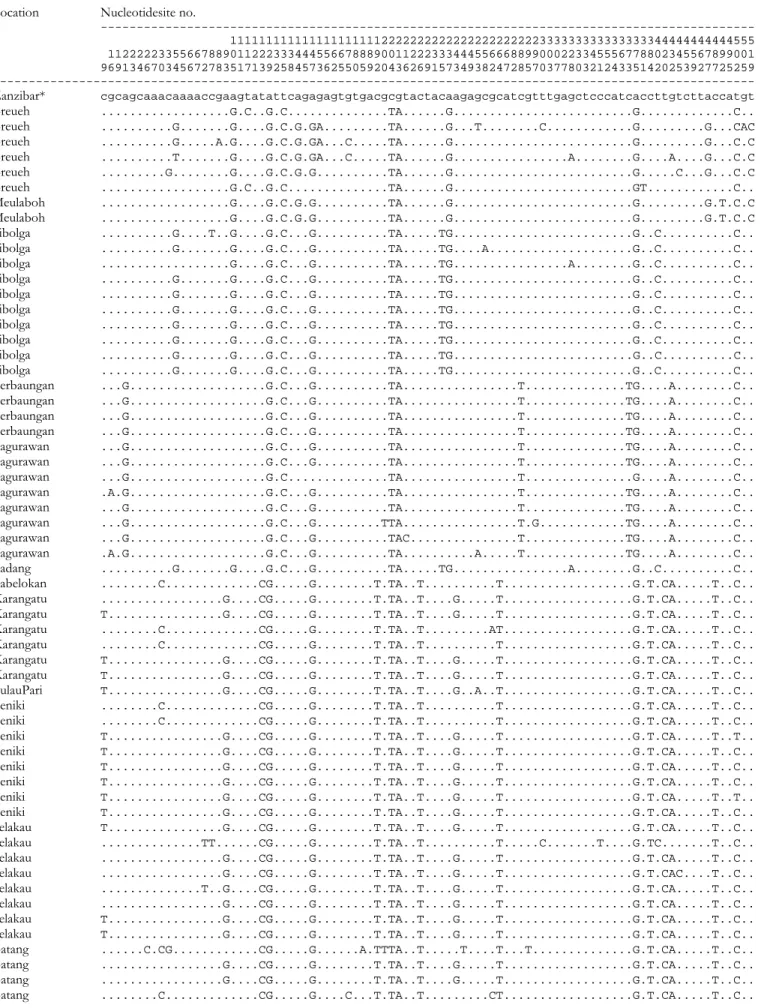HAL Id: ird-00725423
https://hal.ird.fr/ird-00725423v2
Submitted on 4 Mar 2013
HAL is a multi-disciplinary open access
archive for the deposit and dissemination of
sci-entific research documents, whether they are
pub-lished or not. The documents may come from
teaching and research institutions in France or
abroad, or from public or private research centers.
L’archive ouverte pluridisciplinaire HAL, est
destinée au dépôt et à la diffusion de documents
scientifiques de niveau recherche, publiés ou non,
émanant des établissements d’enseignement et de
recherche français ou étrangers, des laboratoires
publics ou privés.
Geographic structure of masked stingray in the
Indo-Malay-Papua archipelago
Irma Arlyza, Philippe Borsa
To cite this version:
Irma Arlyza, Philippe Borsa. Geographic structure of masked stingray in the Indo-Malay-Papua
archipelago. 2010. �ird-00725423v2�
0
.0
1
Geographic structure of masked stingray
in the Indo-Malay-Papua archipelago
Irma S. Arlyza, Philippe Borsa
(LIPI P2O, Jakarta, Indonesia; IRD-UR 227, Montpellier, France)
Conclusions
Unexpectedly strong geographic composition was uncovered in Neotrygon kuhlii. It is sensible to assume that the shallow-benthic habits and the lack of egg and
juvenile dispersal enhance geographic isolation in this species.
It has been argued that deeply divergent mitochondrial lineages in Neotrygon kuhlii may indicate cryptic species (R.D. Ward et al., Mar. Freshw. Res. 2008).
Testing that hypothesis requires the use of nuclear-DNA markers on adequately chosen samples.
Results
Six deeply divergent lineages were observed. Separate
lineages corresponded to separate geographic regions, with
no, or very little, overlap. Further geographic partition was
evident, with some populations or groups of populations within
a region being characterized by private haplogroups.
The topology of the tree suggests that the ancestral form that
gave rise to the present-day Neotrygon kuhlii populations was
in the West Pacific rather than the Coral Triangle. Bootstrap
scores were not sufficient yet to provide a watertight support to
this hypothesis, which makes increasing the length of the
assayed marker our priority.
The 2010 In
ter
na
tional meeting of the A
sso
cia
tion f
or T
ropic
al B
iolo
g
y and C
onser
va
tion,
“
Tr
opic
al
bio
div
ersit
y:
sur
viving the f
o
o
d,
ener
g
y and clima
te cr
isis
”, 19-23 J
uly 2010,
D
enpasar
The blue-spotted or masked stingray, Neotrygon kuhlii
(Myliobatiformes: Dasyatidae), is one of the most common
elasmobranch species from the Indo-Malay-Papuan waters,
where it occurs in reef-associated habitats. For rationally
managed exploitation, it is important to acquire fundamental
knowledge of its stock structure.
Another issue is the origin of the high marine biodiversity in the
Indo-Malay-Papuan archipelago at the core of the Coral
Triangle, which is the global epicentre for marine biodiversity
(P.H. Barber, J. Biogeogr. 2009). Does speciation occur within
the Coral Triangle?
We used the mitochondrial DNA marker to investigate (1) the
population geographic structure and (2) the phylogeography of
Neotrygon kuhlii in the central Indo-West Pacific seas.
Methods
Neotrygon kuhlii specimens were collected from 21 local
fish-landing places throughout Indonesia, in West Papua, and in
New Caledonia. Tissue samples of a total N = 102 individuals
were collected. The nucleotide sequences of a fragment (611
bp) of the COX-I gene were produced. Homologous sequences
from GenBank (Neotrygon kuhlii from Java, Bali, Taiwan, Japan
and Queensland) were added to the dataset. A neighbor-joining
tree of haplotypes (Kimura-2 parameter distances) was
produced.
9 9 9 6 6 6 9 9 9 4 8 5 8 2 9 0 9 8 7 8 8 4 5 4 9 9 5 1 7 8 6 5 5 6 8 0 6 30°
35°N
115°E
160°E
LIPI
Table S1. Variable nucleotide sites in Neotrygon kuhlii haplotypes (
COI gene fragment, 519 bp). Asterisks indicate sequences that were retrieved from
GenBank (http://www.ncbi.nlm.nih.gov/).
---
Location
Nucleotidesite no.
--- 1111111111111111111112222222222222222222222333333333333333344444444444555 112222233556678890112223334445566788890011222333444556668899000223345556778802345567899001 9691346703456727835171392584573625505920436269157349382472857037780321243351420253927725259 ---
